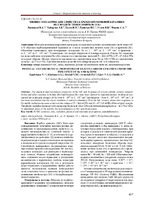| dc.contributor.author | Лапицкая, В. А. | ru |
| dc.contributor.author | Хабарова, А. В. | ru |
| dc.contributor.author | Холод, В. М. | ru |
| dc.contributor.author | Гринчук, П. С. | ru |
| dc.contributor.author | Углов, В. В. | ru |
| dc.contributor.author | Чижик, С. А. | ru |
| dc.coverage.spatial | Минск | ru |
| dc.date.accessioned | 2023-12-21T07:32:25Z | |
| dc.date.available | 2023-12-21T07:32:25Z | |
| dc.date.issued | 2023 | |
| dc.identifier.citation | Физико-механические свойства карбидокремниевой керамики под воздействием ионов He И Kr = Physical and mechanical properties of silicon carbide ceramics under the influence of He И Kr ions / В. А. Лапицкая [и др.] // Приборостроение-2023 : материалы 16-й Международной научно-технической конференции, 15-17 ноября 2023 года, Минск, Республика Беларусь / редкол.: О. К. Гусев (пред.) [и др.]. – Минск : БНТУ, 2023. – С. 417-418. | ru |
| dc.identifier.uri | https://rep.bntu.by/handle/data/138605 | |
| dc.description.abstract | Методом наноиндентирования проведены исследования физико-механических свойств фаз SiC и Si образцов карбидокренмиевой керамики до и после воздействия ионами гелия (He) и криптона (Kr). Облучение проводилось при интегралных дозировках He от 1 · 1014 до 2 · 1017 см–2 и криптона – от 1 · 1013 до 5 · 1015 см–2. Установлено, что модуль упругости Е и микротвердость Н фазы SiC керамики после воздействия излучения He и Kr снижаются относительно значений Е = 366±4 ГПа и Н = 47,2±0,4 ГПа исходного образца. Модуль упругости уменьшается с увеличением дозы He до 249±3 ГПа и с увеличением дозы Kr – до 274±3 ГПа. При максимальных дозах He и Kr микротвердость SiC и Si снижается. | ru |
| dc.language.iso | ru | ru |
| dc.publisher | БНТУ | ru |
| dc.title | Физико-механические свойства карбидокремниевой керамики под воздействием ионов He И Kr | ru |
| dc.title.alternative | Physical and mechanical properties of silicon carbide ceramics under the influence of He И Kr ions | ru |
| dc.type | Working Paper | ru |
| local.description.annotation | The physical and mechanical properties of the SiC and Si phases of silicon carbide ceramic samples before and after exposure to helium (He) and krypton (Kr) ions were studied by nanoindentation. Irradiation was carried out at integral dosages of He from 1 · 1014 to 2 · 1017 cm–2 and krypton – from 1 · 1013 to 5 · 1015 cm–2. It has been established that the elastic modulus E and microhardness H of the SiC ceramic phase after exposure to He and Kr radiation decrease relative to the values of E = 366±4 GPa and H = 47.2±0.4 GPa of the original sample. The elastic modulus decreases with increasing He dose to 24±3 GPa and with increasing Kr dose – to 274±3 GPa. At maximum doses of He and Kr, the microhardness of SiC and Si decreases. | ru |

